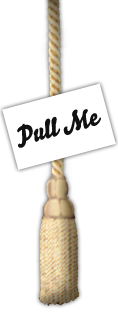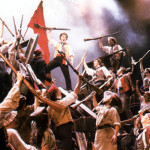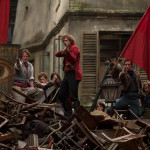FILM: Do You Hear the People Sing?
Act II of the stage version opens with an orchestral reprise of “Do You Hear the People Sing” – which probably inspired the filmmakers to move the song itself to this point. In doing so, they give it a much more dramatic context: General Lamarque’s funeral. No ragtag tablecloth waving on a cart in this version of the song! Here we see the rebels waiting patiently among the mourners, then softly beginning to sing as the procession approaches. As onstage, Enjolras initiates the singing, but the others all quickly join in and the bulk of the song is sung by the chorus en masse. The music crescendos as more and more of the crowd joins in, as Enjolras takes up a flag, and as the students climb onto Larmarque’s hearse itself to preach their message and take over the procession.
Rather than ending on the joyously stirring note of the stage version, the song ends in suspense followed by bloodshed. The cavalry squares off against the rebels and a soldier fires his gun, accidentally killing an innocent old woman bystander. This leads to a riot, which culminates in Enjolras shouting “To the barricades!”
Upon These Stones (Building the Barricade)
Since the stage barricade is actually a giant piece of stage machinery, we don’t see it being built. At the start of Act II, Enjolras declares to his followers (in song) that “upon these stones we will build our barricade,” and after “The Letter” and “On My Own,” we come back to find it already built. But this didn’t satisfy the filmmakers: instead they give us a grand barricade-building sequence. Furniture and rifles are thrown down from windows as well as carried from the café, an omnibus is is overturned, and it all piles up in the street at a thrilling rate, interspersed with some humor involving Grantaire and the café women. (Also unique to film is Marius saying “Get off your arse!” to the slacking Grantaire – stage Marius never uses such language!) Both this scene and the stage version’s “Upon These Stones” culminate in the disguised Javert volunteering to “spy” on the enemy.
At this point onstage, Éponine enters in her boy disguise and Marius notices her. When warning her of the danger proves futile, he sends her away by giving her a farewell letter to take to Cosette.
STAGE: The Letter
Éponine takes the letter to Rue Plumet, which Valjean and Cosette somewhat inexplicably haven’t left yet despite the late hour (TSOD). Valjean catches her at the gate, insists that she give him the letter and reads it as soon as she leaves. The scene ends before we can see how he responds.
STAGE: On My Own
Instead we follow Éponine, who now sings her famous solo, which also includes an introduction (“And now I’m all alone again…”) cut from the film. As her penultimate scene before her death, it serves, more than it does onscreen, as the climax and summing up of her entire role.
The Barricade
The classic Nunn/Caird production’s image of the barricade’s two massive halves sliding from the wings and joining together at center stage is one of the stage show’s most iconic and most epic moments. It’s probably the chief reason why that mostly-minimalistic production has such a grand “megamusical” reputation. Depending on which version of the score is used, the rebels enter and sing either a lengthy pledge to hold the barricade or a simple reprise of “Red and Black.” The film opts for the “Red and Black” reprise, which concludes the barricade-building sequence. Onstage there are women as well as men among the rebels, but on film, less PC but truer to Hugo, no women are involved except the disguised Éponine.
The arrival of the National Guard is heralded at this point onstage by a flourish of brass and the offstage voice of an officer warning the rebels to give up their guns or die. In a reprise of the “Red and Black” melody they defy the warning. This is cut from the film.
Javert’s Arrival/Little People
On film a time skip now takes us from day to night. Javert’s arrival is unchanged, except that he lies that the army will attack “when it’s light” rather than “from the right.” Once Gavroche exposes him, though, heavy cuts are in evidence. Ever since 2006, “Little People” has lost its chorus at this point in most stage productions, and likewise on film that chorus is only heard later at Gavroche’s death. Also omitted is an argument that ensues among the stage students about whether or not to kill Javert. This cut hardly robs the scene of tension, though, because instead of resigning himself to capture, film Javert puts up a vicious fight and needs to be subdued with a fierce blow to the head from Enjolras.
STAGE: A Little Fall of Rain
At this point onstage, gunshots herald Éponine’s reappearance. She initially hides her wound from Marius, but soon collapses in his arms, and he opens her coat to reveal her blouse covered with blood. As she dies in his arms, the other rebels gradually realize what’s happening, gather and look on, creating a moving stage tableau. (Maybe not a unique one, evoking as it does Tony’s death in West Side Story and Satine’s death in Moulin Rouge! but one that works every time.) In the end Enjolras eulogizes Éponine as the first rebel to fall and the students vow to fight in her name.
FILM: The First Attack
On film Javert’s capture is followed not by a sentimental death scene, but by the ominous marching footsteps of hundreds of soldiers, who advance toward the barricade. One novel-inspired exchange later (“Who’s there?”/”French revolution!”) and the attack begins. The battle is slightly longer than onstage and enhanced with real gunfire and chaos.
It’s here that film Éponine receives her fatal wound: a soldier shoots at Marius but Éponine takes the bullet for him, as she does in the novel. Thus her death is changed from a random turn of fate to the heroic, redeeming sacrifice that Hugo intended. And she isn’t the only one whose heroism from the novel is brought back. The battle is won when Marius faces the soldiers with a torch and a powder keg and threatens to blow up the barricade, including himself, unless the soldiers retreat. Eddie Redmayne apparently felt strongly about instating this passage from Hugo, to make Marius more than just a “romantic stereotype.”
FILM: A Little Fall of Rain
The recitative exchange between stage Marius and Éponine is replaced with dialogue, as Marius finds the dying girl on the ground and she finally gives him Cosette’s letter. Their duet is somewhat drastically shortened, but enhanced by real falling rain and close-ups. The tableau of all the rebels gazing at them is gone, as is the eulogizing at the end. Instead only Enjolras, Gavroche and a few others look on, and a wide shot reveals the ground littered with dead or dying students, several being held in their friends’ arms just as Marius holds Éponine.
After Éponine’s body is taken away, Marius reads Cosette’s letter, writes a reply and gives it to Gavroche to deliver. Which leads to…
FILM: The Letter
Marius’s letter itself is identical on film and stage, but otherwise this is a new scene. The setting is the Rue de l’Homme-Armé lodging house, Valjean and Éponine’s recitative exchange is replaced by spoken dialogue between Valjean and Gavroche, and most importantly, we stay with Valjean after he reads the letter. He expresses horror that a young man has come to steal “the treasure of my autumn days” from him, then sets off to “find this boy,” possibly not knowing whether he wants to save him or kill him. We see him steal a uniform from a dead soldier at an already-fallen barricade, make his way through the soldiers’ lines in disguise, and finally arrive at “our” barricade.
Valjean’s Arrival
The rebels’ interrogation of Valjean is shortened on film and ended not by the arrival of the enemy, as onstage, but by Gavroche vouching for him as a friend. At this point Valjean spots army snipers lurking on a nearby building and leads the students in driving them off with gunfire: an incident that onstage takes place in the middle of…
STAGE: The First Attack
The First Attack is briefer and less dramatic onstage than on film. The rebels manage to drive back the enemy with their united force and the battle ends with no casualties on their side.
Javert’s Release
Whether the sniper incident happens mid-battle or not, it leads to the grateful Enjolras allowing Valjean to “take care” of Javert. Onstage he follows this with a warning to the others that the enemy may be regrouping, not heard in the film (though his later line “They won’t attack until it’s light” is ominously changed to “They may attack before it’s light”). Onstage, TSOD comes into force here: Valjean frees Javert in a corner of the barricade just barely out of the rebels’ line of vision. The film adds not only realism, but suspense as Valjean leads his nemesis out to the back of the café, where no one will see them. After, freeing Javert, the address he gives him is “Rue de l’Homme-Armé, Number 5” instead of “Number 55, Rue Plumet,” and instead of firing his gun into the air at the end, he shoots the wall, purposefully just missing Javert’s head.
Drink With Me
The rebels’ evening song loses its first two stanzas on film, with the result that Grantaire loses his central moment of characterization. Onstage, in what one fan has argued is the most important solo in the musical, Grantaire takes up his friends’ melody but replaces the sentimental lyrics with biting cynicism, implying that the rebels are all doomed to die pointless deaths, having lived pointless lives. This establishes him as more than just a “class clown,” but as a man who believes in nothing, which makes it all the more moving when he chooses to die with his friends anyway.
Onstage, after Grantaire’s verse, the song becomes a call-and-response between the men and the women. On film, with no women present, their vocal part is given to Gavroche. Also, stage Marius’s lapse into poetic third-person speech, “Would you weep, Cosette, should Marius fall?” becomes the more plainspoken “…if I were to fall?” onscreen.
Bring Him Home
Onstage Valjean sings this entire song by Marius’s side, while on film he starts in the café and only gradually makes his way to Marius. The concluding overhead shot, revealing the pitifully small barricade surrounded by masses and masses of soldiers, is also, of course, unique to the film.






Michele Serchuk
January 6th, 2013 at 15:59
I agree with your statement about the grand-ness of the stage barricade as compared to the mostly minimalist sets. In a way, that contrast is more powerful than the hugely dramatic building etc. from the movie. I think that the stage offers more dramatic impact. Just my never to be humble opinion.
Steve
February 28th, 2013 at 01:57
“At this point onstage, Éponine enters in her boy disguise and Marius notices her. When warning her of the danger proves futile, he sends her away by giving her a farewell letter to take to Cosette.”
At this point on stage, Marius is concerned for Eponine and tells her to get away from the barricades and then giving her the letter.
In the film, I don’t recall any concern for Eponine’s wellbeing from Marius and also Eponine’s “I’ve got you worried now…. that shows you like me quite a lot'” is missing (I think – though I may be wrong) from the film – although this scene is present in the screenplay script I think it is cut from the end product (can anyone say for sure?).
Therefore, I don’t think the film has any references to Eponine being a ‘boy’ – not by Valjean or Marius. Can anyone confirm this?
Appleby
April 11th, 2013 at 20:32
They Don’t give any direct reference to it. Although she is seen wrapping her bosom down and putting her hair up into a hat. Assuming-ly to appear as a boy.
Steve
February 28th, 2013 at 02:06
“A little fall of rain – The tableau of all the rebels gazing at them is gone, as is the eulogizing at the end”
I remember some eulogizing in the film with Marius telling people her name and saying she was the first to die and that her death will not be in vain – maybe I’m confusing this with the stage show though….
Steve
February 28th, 2013 at 02:10
“The letter – Valjean and Éponine’s recitative exchange is replaced by spoken dialogue between Valjean and Gavroch”
On stage, I remember Valjean offering Eponine a tip for delivering the letter, but In the film Gavroch actually demands the tip.
Steve
February 28th, 2013 at 02:13
“Javert’s release – Onstage he follows this with a warning to the others that the enemy may be regrouping, not heard in the film (though his later line “They won’t attack until it’s light” is ominously changed to “They may attack before it’s light”).”
The regrouping line is present in the screenplay script however – but may have been cut from the finished film – deleted scene on DVD release maybe?
best earbuds 2015
May 29th, 2015 at 08:22
Hello there! This article couldn’t be written any better! Looking through
this post reminds me of my previous roommate! He continually kept talking about this.
I am going to forward this information to him. Pretty sure he’ll have a good
read. Thanks for sharing!
kindersitz test 2015
June 5th, 2015 at 08:55
Hello there! I could have sworn I’ve been to this blog
before but after checking through some of the post I realized it’s new to me.
Anyways, I’m definitely happy I found it and I’ll be bookmarking and checking back frequently!